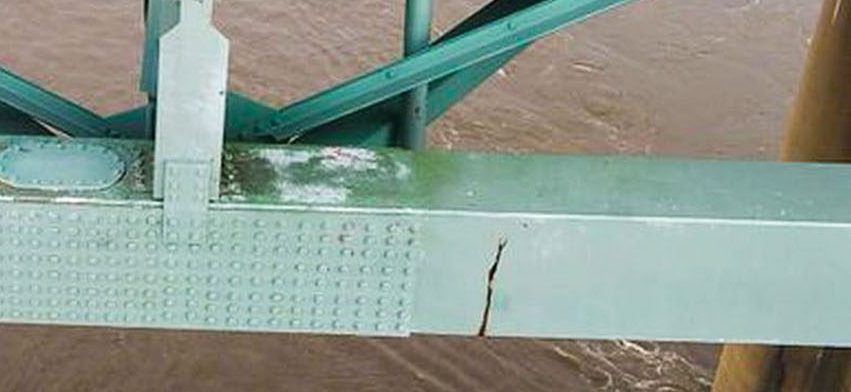The Arkansas Department of Transportation (ARDOT) has fired a bridge inspector whom the agency said did not report a steel beam’s crack that worsened, leading to the Mississippi River closing for three days earlier this month.
The Hernando de Soto Bridge was closed to both river and highway traffic May 11 after a contractor for the Arkansas Department of Transportation found what transportation officials called a fracture in a major structural support beam crucial to the bridge’s integrity. The contractor called 911, asking that all traffic immediately be diverted.
River traffic reopened between Mile 736 and Mile 737 on May 14, but traffic over the bridge, which carries Interstate 40 between Memphis, Tenn., and West Memphis, Ark., has been diverted to the only other Memphis area crossing, on I-55.
By the time the river reopened, 62 vessels and 1,058 barges were queued, U.S. Coast Guard Sector Lower Mississippi reported. Tennessee Transportation Commissioner Clay Bright said as of the evening of May 15, about 800 barges and their accompanying vessels had cleared the queue.
“Based on information provided to us by the Tennessee Department of Transportation, the Coast Guard has determined that transit under the I-40 bridge is safe for maritime traffic,” said Coast Guard Capt. Ryan Rhodes, Captain of the Port of Memphis. “We appreciate the cooperative efforts of both the Tennessee and Arkansas Departments of Transportation, as well as maritime port partners, to ensure the safety of our waterway.”
In a news conference May 17, ARDOT Director Lorie Tudor announced that an investigation had determined the same ARDOT bridge inspector who inspected the bridge in both 2019 and 2020 had failed to notice the crack, although drone video footage captured its presence.
“We should have discovered this crack in the beam in 2019, and we are taking steps to hold those responsible for not doing their jobs accountable. But more importantly, to correct the flaws in our process,” Tudor said.
The employee was experienced, having about 15 years of inspection experience. He didn’t notice the crack because he did not follow proper protocols, she said.
Tudor added that that Michael Baker International, the contractor who noticed the crack on the first day of the 2021 routine annual inspection, was not responsible for the inspections in 2019 and 2020.
Tudor said that, following the termination of the employee, the investigation had been referred to federal authorities for possible federal charges.
ARDOT and the Tennessee Department of Transportation (TDOT) co-own and share responsibility for the bridge, with Arkansas normally taking the lead on inspections and Tennessee doing so on maintenance and repairs and both states equally splitting the costs.
After receiving approval from the federal government for an emergency contract, the states hired Kiewit Infrastructure of Omaha, Neb., to oversee repairs. Kiewit and TDOT announced the timeline for repairs May 18 during a news conference with Tennessee Gov. Asa Hutchinson and Arkansas Gov. Bill Lee.
The first phase will add two 35-foot steel plates—weighing 18,000 pounds each—on either side of the fracture to strengthen the bridge for contractors and equipment to work on the next phase of repairs, Bright said. Stupp Bridge of Bowling Green, Ky., is fabricating the plates and is expected to have them completed within a few days, Bright said, adding that TDOT had trucks on standby to pick them up as soon as fabrication was complete. Installation could take about another week.
The second phase of the project will cut out and replace the damaged beam and inspect the bridge for any additional concerns that need to be addressed before vehicular traffic is allowed to resume. Bright said that phase would involve people and equipment working from barges beneath the bridge. Repairs are expected to take several months.
“We will work to repair this in the shortest time possible, but we will not compromise the safety of the workers or the safety of the citizens that will drive across that bridge for the sake of finishing early,” Lee said.
Hutchinson stressed that it was important for the two states and all their partners, including federal and municipal entities and private industry, to continue working together to expedite repairs.
“This is not the first issue we have worked on, but there is not a more important issue that we have worked on in terms of the flow of commerce and the safety of our citizens,” he said.
A website following the status of the bridge’s repairs has been established at https://www.ardot.gov/divisions/public-information/40-ms-river-bridge/.
Caption for photo: A photo from 2019 shows a crack in the Hernando de Soto Bridge that was missed at the time.



